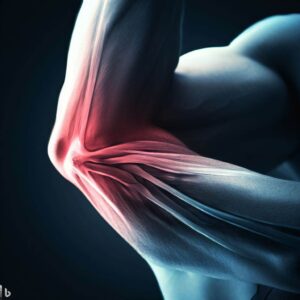Distal Biceps Tendon Tear at Elbow

A distal biceps tendon tear at the elbow causes sharp, sudden pain when bending the elbow and is accompanied by a popping sensation. Patients may notice a change in the appearance of the upper arm (the biceps muscle moves toward the shoulder) or the appearance of a hematoma (bruise) on the inner side of the elbow and forearm, near the radius bone.
A distal biceps tendon tear at the elbow can coexist with other conditions such as elbow osteoarthritis. If you experience symptoms like sharp pain, popping sensation, changes in upper arm appearance, or a hematoma, consult a medical professional like Dr. Marc Beauchamp for evaluation and treatment.
Understanding Distal Biceps Tendon Tear at Elbow
A distal biceps tendon rupture at the elbow occurs when the tendon that connects the biceps muscle to the elbow is partially or completely torn. This can happen due to sudden trauma, such as lifting a heavy object or falling on an outstretched arm, or from overuse and degeneration of the tendon over time. The tear typically occurs during activities involving flexion of the elbow.
When a distal biceps tendon tear occurs, it can activate the pain sensors, resulting in a sudden and sharp pain sensation felt at the front of the elbow. This pain may be accompanied by a popping or snapping feeling. Some people also experience swelling, bruising, and weakness in the affected arm.
Heavy weightlifters can be an example. The weightlifting exercises that involve lifting heavy weights with the arm extended. For instance, during a bicep curl, if the weight is too heavy or if the arm is not lifted properly, it can cause the biceps tendon to tear. The reason for this urgency is that the biceps muscle experiences substantial tension when the arm is extended, and forceful movements can result in a complete rupture of the tendon.
Additionally, the risk of developing a distal biceps tendon tear increases with age and in individuals who smoke or have a history of steroid use.
Risks factors and Prevention
While distal biceps tendon rupture can occur from sudden injury or trauma, there are also several risk factors that may increase your chances of experiencing this type of injury.
However, it’s worth mentioning that nonsurgical treatment options are available for managing certain cases of distal biceps tendon tears. Being aware and taking preventive measures can help reduce your risk of a distal biceps tendon tear at the elbow.
Smoking can also weaken the tendons and decrease blood flow to the area, increasing the risk of tears. Additionally, repetitive overhead activities such as weightlifting, throwing a ball, or reaching overhead can put a significant amount of strain on the biceps tendon, leading to tears over time. Such tears may necessitate surgical intervention, involving the use of sutures to mend the damaged tendon.
Maintaining good overall health by eating a balanced diet and getting regular exercise can help keep tendons strong and flexible. You can also reduce your risk by avoiding smoking and limiting your alcohol intake.
If you participate in activities that involve repetitive overhead motions, it is important to take breaks and stretch regularly to prevent overuse injuries. Proper technique and form are also essential to reducing your risk of a distal biceps tendon tear. If you are unsure about proper form, consult with a trainer or coach who can help you avoid injury.
Warming up before exercise and cooling down afterward can also help reduce your risk of injury. To prepare the muscles and tendons for forceful biceps activity, a proper warm-up routine should incorporate stretching and light aerobic exercises. Cooling down with stretching and gentle movements can help prevent muscle soreness and stiffness.
Several factors contribute to the risk of a distal biceps tendon tear, including age, smoking, steroid usage, and engaging in physical activities that involve repetitive overhead motion. As we age, our tendons become less flexible and more prone to tears. Men have a higher likelihood of experiencing distal biceps tendon tears compared to women. This disparity may be attributed to variances in muscle strength and anatomical factors that contribute to additional strength in men.
In order to avoid experiencing a distal biceps tendon tear and prevent the subsequent loss of strength, it is essential to prioritize overall health, refrain from smoking and using steroids. Additionally, it is important to use proper lifting techniques and avoid overloading the biceps with heavy weights or repetitive motions.
Symptoms and Diagnosis
Symptoms:
- Sudden pain in the elbow that may radiate to the forearm
- A “pop” or tearing sensation at the elbow
- Weakness in the elbow and forearm
- Difficulty bending the elbow or turning the forearm
- Swelling and bruising around the elbow and forearm
- A visible bulge or “Popeye” deformity near the elbow, caused by the biceps muscle retracting
Review of diagnosis:
- Physical examination: A doctor or orthopedic specialist will examine the affected arm muscle, looking for visible deformities, bruising, and swelling. They may also perform strength and range of motion tests to evaluate the extent of the injury
- Imaging tests: X-rays can help identify any larger bone fractures or dislocations that may have occurred along with the biceps tendon tear
- An MRI or ultrasound can provide a more detailed image of the soft tissues around the elbow, including the biceps tendon. These imaging techniques offer a detailed view of the fibrous tissue in the area
- Electromyography (EMG): This test measures the electrical activity in the muscles and nerves, and can help diagnose nerve damage or other issues related to the biceps tendon tear
The most notable indication of a distal biceps tendon tear is the sudden onset of sharp elbow pain at the time of injury.
Swelling and bruising may also occur. Over time, weakness in the affected arm and difficulty with activities that involve bending or lifting may develop. To diagnose a distal biceps tendon tear, a healthcare provider will perform a physical exam. They may also order imaging tests such as an MRI or ultrasound to confirm the diagnosis and assess the severity of the tear.
It is important to seek prompt medical attention if a distal biceps tendon tear is suspected, as delay in treatment may result in long-term weakness and disability.
Due to the similarities in symptoms with other conditions like sprains or strains, accurately diagnosing a ruptured biceps tendon is crucial to ensure appropriate treatment. It is important to seek a precise diagnosis to receive the necessary care for a distal biceps tendon tear.
What are the repercussions for distal bicep tendon tear at elbow?
The occurrence of this condition can be attributed to factors such as a fall or the sudden contraction of the bicep muscle. If it is unclear whether a partial or complete tear has occurred, an MRI must be performed within two to three days. Distal biceps rupture are considered urgent cases and must be treated within the first several weeks following the injury.
What are the non-surgical distal bicep tendon tear treatments?
If a decision is made not to operate on the tear, either due to the patient’s sedentary lifestyle or in cases of recurrent tears, there are alternative options available:
- Rest
- Physiotherapy for several weeks
What is the surgical treatment?
When it is determined that surgery is necessary, it is crucial to perform the surgical procedure for a distal biceps tendon tear. This should be done within three weeks of the initial injury, with special attention to the elbow joint. The operation uses the arthroscopic method of reinserting the tendon into the bone with a special anchor.
About the procedure
- Outpatient procedure
- To perform the procedure, a skin incision is required
- Length of procedure: 60 to 90 minutes
- General anesthesia – the patient is asleep during the procedure
- Delicate surgery with risk of damage to blood vessels and nerves Must be performed by an elbow specialist
Post-surgical recovery
The patient must be escorted home after the procedure. The elbow must be completely immobilized for three weeks post surgery. A motion brace is placed on the elbow immediately after surgery. This motion brace minimizes potential complications and facilitates the recovery process.
About recovery
- Progressive mobilization is possible approximately four weeks post operation (a protective splint must be worn for three more weeks). This approach allows for gradual movement and physical therapy to aid in the recovery process
- Progressive biceps strengthening starts seven to eight weeks post operation
- Resumption of regular activities after four to five months, as tolerated by the patient. Minimal activity is recommended during the recovery period
- Success rate: 90% (return to normal elbow function)
An expert for your bicep tendon tear at elbow
Find out the post-operative instructions to follow after a surgery from Dr. Marc Beauchamp. He is an expert in elbow and shoulder surgery and is one of the 3 most qualified orthopaedic surgeons in Montreal.
Ease your pain fast
Dr. Marc Beauchamp: the doctor for shoulder and elbow pain





